Fugitive Dust Associated with Scrap Metal Processing
Abstract
:1. Introduction
2. Materials and Methods
2.1. Case Study Facility
2.2. Environmental Sampling
2.3. Sample Analysis
2.4. Data Analysis
3. Results
3.1. Composition and Spatial Distribution of Soil and Road Dust Measurements
3.2. Composition and Spatial Distribution of Wipe Samples
3.3. Comparison of Soil/Sediment and Wipe Samples
4. Discussion
4.1. Comparison with Literature
4.1.1. Soil Surveys
4.1.2. Air Quality Monitoring
4.1.3. Chemical Profiles
4.2. Health Risks
4.3. Improving FD Assessment and Management
4.3.1. FD Emissions Inventories
4.3.2. Metal Processers in the Study Area
4.4. FD Monitoring and Community-Based Research
5. Conclusions
Supplementary Materials
Author Contributions
Funding
Data Availability Statement
Acknowledgments
Conflicts of Interest
References
- US EPA (United States Environmental Protection Agency). Fugitive Dust Control Measures and Best Practices. Available online: https://www.epa.gov/system/files/documents/2022-02/fugitive-dust-control-best-practices.pdf (accessed on 5 October 2023).
- Clifford, K.R. Fugitive Dust: How Dust Escapes Regulation and Remains Inscrutable. Available online: https://www.proquest.com/docview/2365359966?pq-origsite=gscholar&fromopenview=true (accessed on 21 September 2023).
- US EPA (United States Environmental Protection Agency). 2020 National Emissions Inventory (NEI) Data. Available online: https://www.epa.gov/air-emissions-inventories/2020-national-emissions-inventory-nei-data (accessed on 16 June 2023).
- Zhao, G.; Chen, Y.; Hopke, P.K.; Holsen, T.M.; Dhaniyala, S. Characteristics of Traffic-Induced Fugitive Dust from Unpaved Roads. Aerosol Sci. Technol. 2017, 51, 1324–1331. [Google Scholar] [CrossRef]
- Ajmone-Marsan, F.; Biasioli, M. Trace Elements in Soils of Urban Areas. Water. Air. Soil Pollut. 2010, 213, 121–143. [Google Scholar] [CrossRef]
- US EPA (United States Environmental Protection Agency). Provisional Peer Reviewed Toxicity Values for Iron and Compounds (CASRN 7439-89-6). Available online: https://cfpub.epa.gov/ncea/pprtv/documents/IronandCompounds.pdf (accessed on 21 September 2023).
- Binner, H.; Sullivan, T.; Jansen, M.A.K.; McNamara, M.E. Metals in Urban Soils of Europe: A Systematic Review. Sci. Total Environ. 2023, 854, 158734. [Google Scholar] [CrossRef] [PubMed]
- Wei, B.; Yang, L. A Review of Heavy Metal Contaminations in Urban Soils, Urban Road Dusts and Agricultural Soils from China. Microchem. J. 2010, 94, 99–107. [Google Scholar] [CrossRef]
- Hanfi, M.Y.; Mostafa, M.Y.A.; Zhukovsky, M.V. Heavy Metal Contamination in Urban Surface Sediments: Sources, Distribution, Contamination Control, and Remediation. Environ. Monit. Assess. 2020, 192, 32. [Google Scholar] [CrossRef]
- Jones, D.H.; Yu, X.; Guo, Q.; Duan, X.; Jia, C. Racial Disparities in the Heavy Metal Contamination of Urban Soil in the Southeastern United States. Int. J. Environ. Res. Public Health 2022, 19, 1105. [Google Scholar] [CrossRef]
- Masri, S.; Lebrón, A.M.W.; Logue, M.D.; Valencia, E.; Ruiz, A.; Reyes, A.; Wu, J. Risk Assessment of Soil Heavy Metal Contamination at the Census Tract Level in the City of Santa Ana, CA: Implications for Health and Environmental Justice. Environ. Sci. Process. Impacts 2021, 23, 812–830. [Google Scholar] [CrossRef]
- Denny, M.; Baskaran, M.; Burdick, S.; Tummala, C.; Dittrich, T. Investigation of Pollutant Metals in Road Dust in a Post-Industrial City: Case Study from Detroit, Michigan. Front. Environ. Sci. 2022, 10, 974237. [Google Scholar] [CrossRef]
- Diawara, D.M.; Litt, J.S.; Unis, D.; Alfonso, N.; Martinez, L.A.; Crock, J.G.; Smith, D.B.; Carsella, J. Arsenic, Cadmium, Lead, and Mercury in Surface Soils, Pueblo, Colorado: Implications for Population Health Risk. Environ. Geochem. Health 2006, 28, 297–315. [Google Scholar] [CrossRef]
- Pasetto, R.; Mattioli, B.; Marsili, D. Environmental Justice in Industrially Contaminated Sites. A Review of Scientific Evidence in the WHO European Region. Int. J. Environ. Res. Public Health 2019, 16, 998. [Google Scholar] [CrossRef]
- MDOT (Michigan Department of Transportation). 2016 Traffic Volumes. Available online: https://gis-michigan.opendata.arcgis.com/datasets/mdot::mdot-traffic-volume-archive/about?layer=10 (accessed on 16 June 2023).
- CD (City of Detroit). Report on Geotechnical Evaluation Ground Upheaval Incident Intersection of Fort and Dearborn Streets Detroit, Michigan. Available online: https://detroitmi.gov/sites/detroitmi.localhost/files/2021-12/Dearborn%20and%20Fort%20-%20Final%20Geotechnical%20Engineers%20Causal%20Report.pdf (accessed on 22 May 2023).
- US EPA (United States Environmental Protection Agency). Interactive Map of Air Quality Monitors. Available online: https://www.epa.gov/outdoor-air-quality-data/interactive-map-air-quality-monitors (accessed on 28 June 2023).
- Xia, T.; Catalan, J.; Hu, C.; Batterman, S. Development of a Mobile Platform for Monitoring Gaseous, Particulate, and Greenhouse Gas (GHG) Pollutants. Environ. Monit. Assess. 2021, 193, 7. [Google Scholar] [CrossRef] [PubMed]
- Chow, J.C.; Lowenthal, D.H.; Chen, L.W.A.; Wang, X.; Watson, J.G. Mass Reconstruction Methods for PM2.5: A Review. Air Qual. Atmos. Heal. 2015, 8, 243–263. [Google Scholar] [CrossRef] [PubMed]
- MDOE (Michigan Department of Environment). Michigan Background Soil Survey Resource Materials. Available online: https://www.michigan.gov/-/media/Project/Websites/egle/Documents/Programs/RRD/Remediation/Resources/Soil-Background-Resource-Materials.pdf?rev=366ee3d499034314b7b5f0990e0e32b8 (accessed on 22 May 2023).
- Howard, J.; Weyhrauch, J.; Loriaux, G.; Schultz, B.; Baskaran, M. Contributions of Artifactual Materials to the Toxicity of Anthropogenic Soils and Street Dusts in a Highly Urbanized Terrain. Environ. Pollut. 2019, 255, 113350. [Google Scholar] [CrossRef] [PubMed]
- Murray, K.S.; Rogers, D.T.; Kaufman, M.M. Heavy Metals in an Urban Watershed in Southeastern Michigan. J. Environ. Qual. 2004, 33, 163–172. [Google Scholar] [CrossRef] [PubMed]
- Yang, Z.; Islam, M.K.; Xia, T.; Batterman, S. Apportionment of PM2.5 Sources across Sites and Time Periods: An Application and Update for Detroit, Michigan. Atmosphere 2023, 14, 592. [Google Scholar] [CrossRef]
- Howard, J.L.; Orlicki, K.M. Composition, Micromorphology and Distribution of Microartifacts in Anthropogenic Soils, Detroit, Michigan, USA. Catena 2016, 138, 103–116. [Google Scholar] [CrossRef]
- US EPA (United States Environmental Protection Agency). SPECIATE. Available online: https://www.epa.gov/air-emissions-modeling/speciate (accessed on 22 May 2023).
- Chalvatzaki, E.; Aleksandropoulou, V.; Glytsos, T.; Lazaridis, M. The Effect of Dust Emissions from Open Storage Piles to Particle Ambient Concentration and Human Exposure. Waste Manag. 2012, 32, 2456–2468. [Google Scholar] [CrossRef]
- Hleis, D.; Fernández-Olmo, I.; Ledoux, F.; Kfoury, A.; Courcot, L.; Desmonts, T.; Courcot, D. Chemical Profile Identification of Fugitive and Confined Particle Emissions from an Integrated Iron and Steelmaking Plant. J. Hazard. Mater. 2013, 250–251, 246–255. [Google Scholar] [CrossRef]
- Li, G.; Sun, G.X.; Ren, Y.; Luo, X.S.; Zhu, Y.G. Urban Soil and Human Health: A Review. Eur. J. Soil Sci. 2018, 69, 196–215. [Google Scholar] [CrossRef]
- US EPA (United States Environmental Protection Agency). Regional Screening Levels (RSLs)—Generic Tables. Available online: https://www.epa.gov/risk/regional-screening-levels-rsls-generic-tables (accessed on 16 June 2023).
- Lin, Z.; Wang, F.; Ji, T.; Ma, B.; Xu, L.; Xu, Q.; He, K. Characteristics and the Potential Influence of Fugitive PM10 Emissions from Enclosed Storage Yards in Iron and Steel Plant. Atmosphere 2020, 11, 833. [Google Scholar] [CrossRef]
- Watson, J.G.; Chow, J.C. Reconciling Urban Fugitive Dust Emissions Inventory and Ambient Source Contribution Estimates: Summary of Current Knowledge and Needed Research. Desert Res. Inst. 2000, 6110.4, 240. [Google Scholar]
- Li, T.; Dong, W.; Dai, Q.; Feng, Y.; Bi, X.; Zhang, Y.; Wu, J. Application and Validation of the Fugitive Dust Source Emission Inventory Compilation Method in Xiong’an New Area, China. Sci. Total Environ. 2021, 798, 149114. [Google Scholar] [CrossRef] [PubMed]
- US EPA (United States Environmental Protection Agency). Method 9—Visual Determination of the Opacity of Emissions from Stationary Sources. Available online: https://www.epa.gov/sites/default/files/2017-08/documents/method_9.pdf (accessed on 27 May 2023).
- US EPA (United States Environmental Protection Agency). Method 22-Visual Determination of Fugitive Emissions from Material Sources and Smoke Emissions from Flares. Available online: https://www.epa.gov/sites/default/files/2019-08/documents/method_22_0.pdf (accessed on 27 May 2023).
- Pedrayes, O.D.; Lema, D.G.; Usamentiaga, R.; García, D.F. Detection and Localization of Fugitive Emissions in Industrial Plants Using Surveillance Cameras. Comput. Ind. 2022, 142, 103731. [Google Scholar] [CrossRef]
- Zafra-Pérez, A.; Boente, C.; de la Campa, A.S.; Gómez-Galán, J.A.; de la Rosa, J.D. A Novel Application of Mobile Low-Cost Sensors for Atmospheric Particulate Matter Monitoring in Open-Pit Mines. Environ. Technol. Innov. 2023, 29, 102974. [Google Scholar] [CrossRef]
- IJC (International Joint Commission). Report of the International Joint Commission United States and Canada on the Pollution of the Atmosphere in the Detroit River Area. Available online: https://ijc.org/en/report-ijc-us-canada-pollution-atmosphere-detroit-river-area (accessed on 22 May 2023).
- Hunt, G.T. “Nuisance Dusts”-Validation and Application of a Novel Dry Deposition Method for Total Dust Fall, in: Air Quality Monitoring, Assessment and Management. Air Qual. Monit. Assess. Manag. IntechOpen 2011, 4, 77–92. [Google Scholar]
- Peters, S.J.W.; Warner, S.M.; Saikawa, E.; Ryan, P.B.; Panuwet, P.; Barr, D.B.; D’Souza, P.E.; Frank, G.; Hernandez, R.; Alvarado, T.; et al. Community-Engaged Assessment of Soil Lead Contamination in Atlanta Urban Growing Spaces. GeoHealth 2023, 7, e2022GH000674. [Google Scholar] [CrossRef]
- Filippelli, G.M.; Adamic, J.; Nichols, D.; Shukle, J.; Frix, E. Mapping the Urban Lead Exposome: A Detailed Analysis of Soil Metal Concentrations at the Household Scale Using Citizen Science. Int. J. Environ. Res. Public Health 2018, 15, 1531. [Google Scholar] [CrossRef]
- Ackerson, J. Soil Sampling Guidelines. Available online: https://www.extension.purdue.edu/extmedia/AY/AY-368-w.pdf (accessed on 28 May 2023).
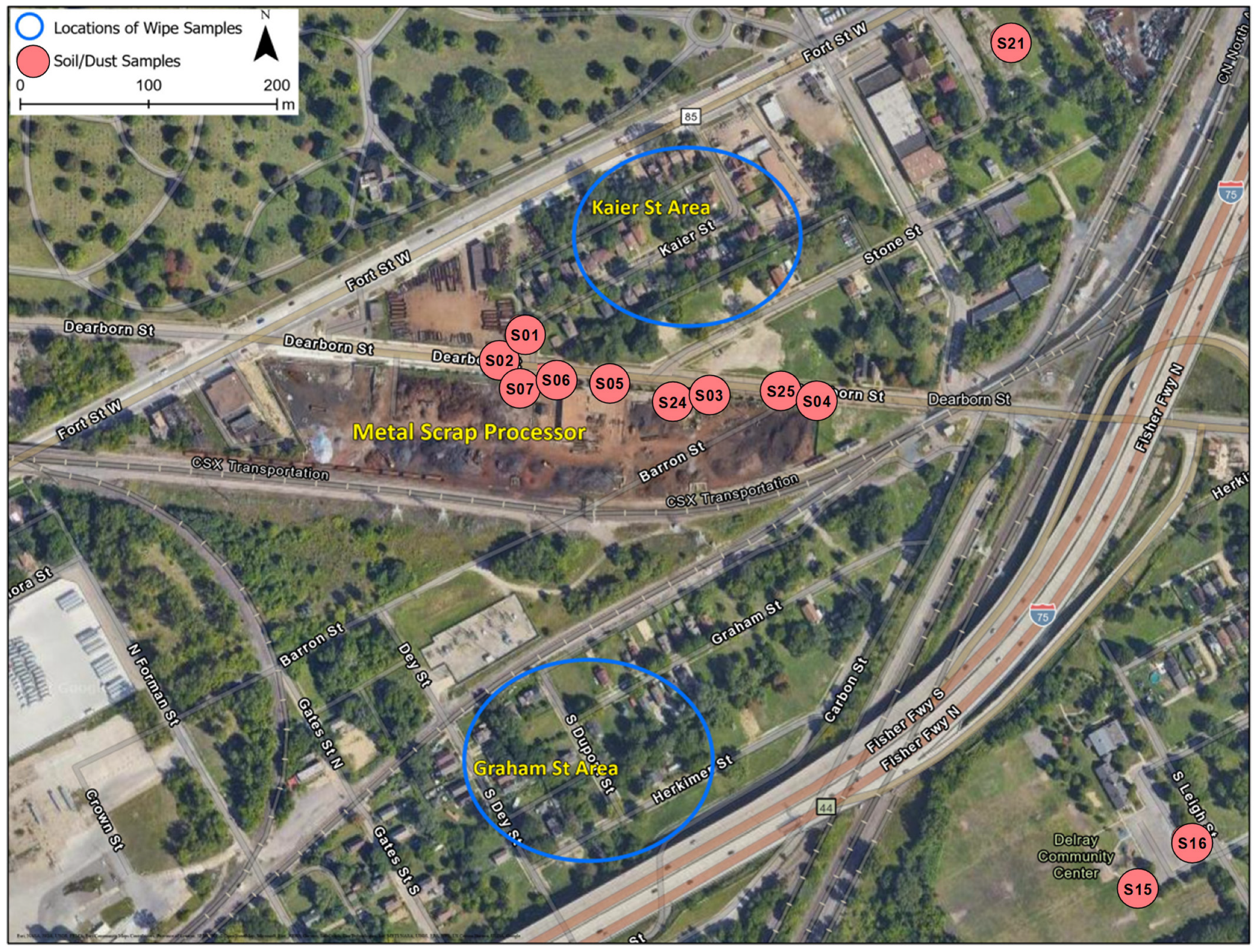

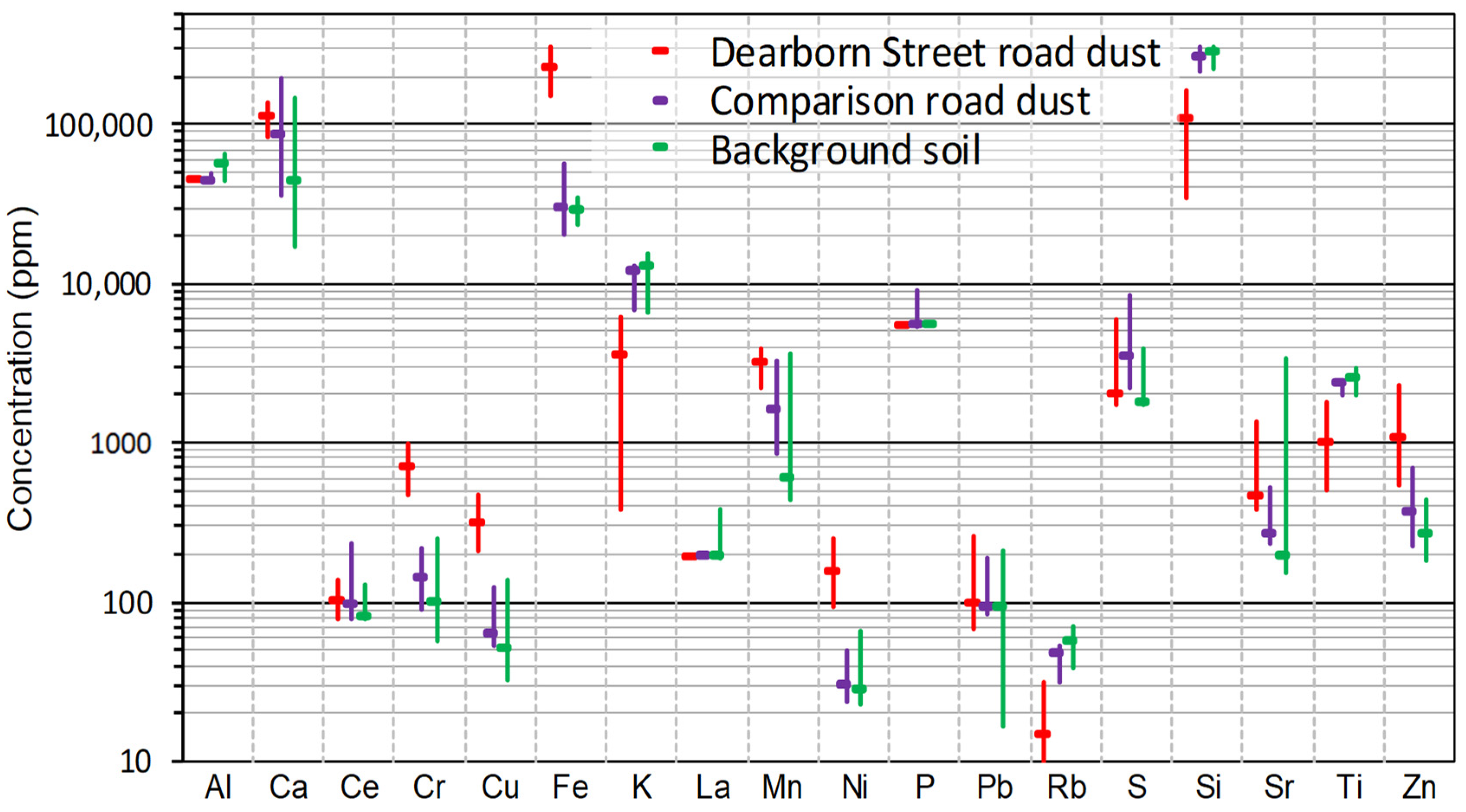

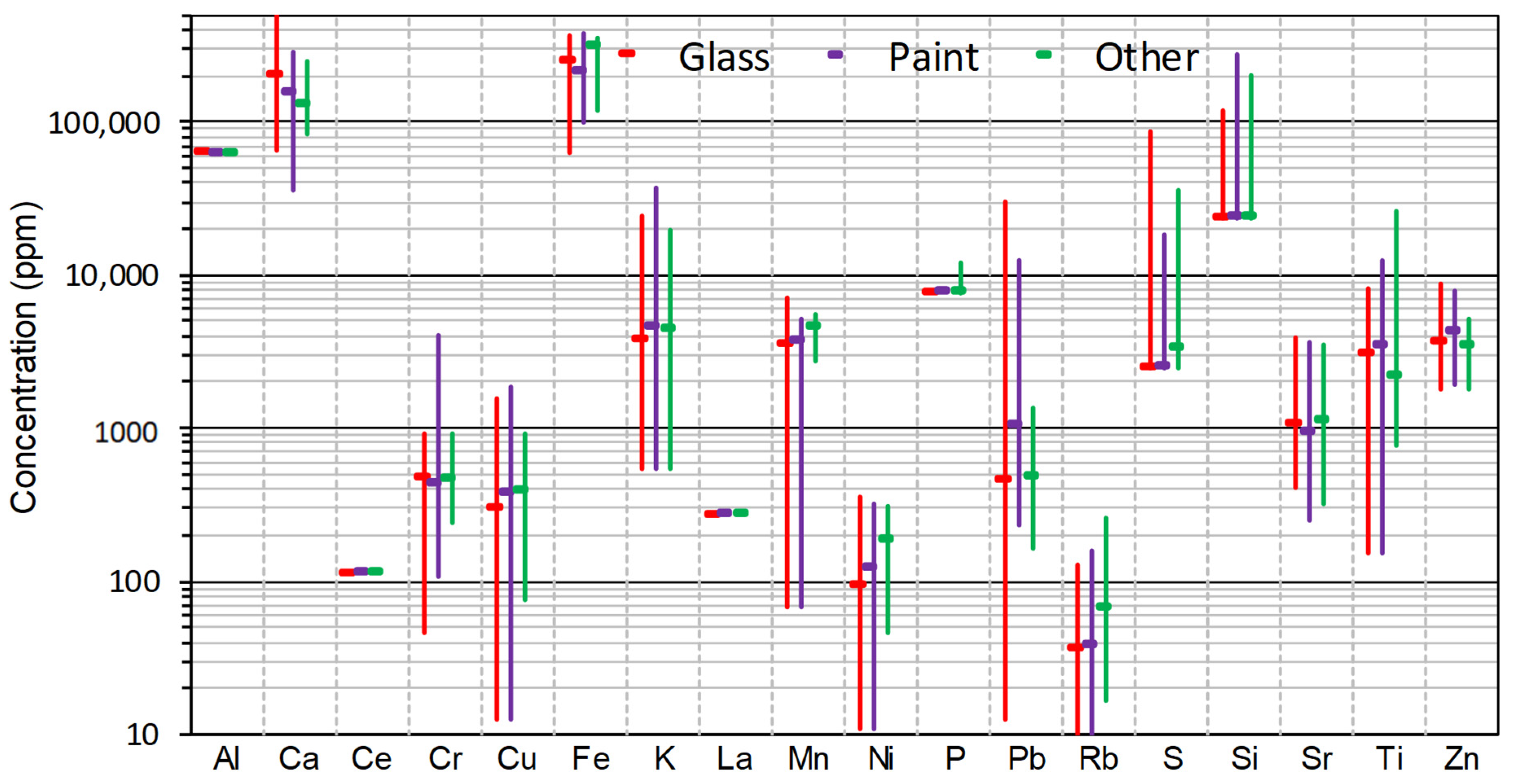
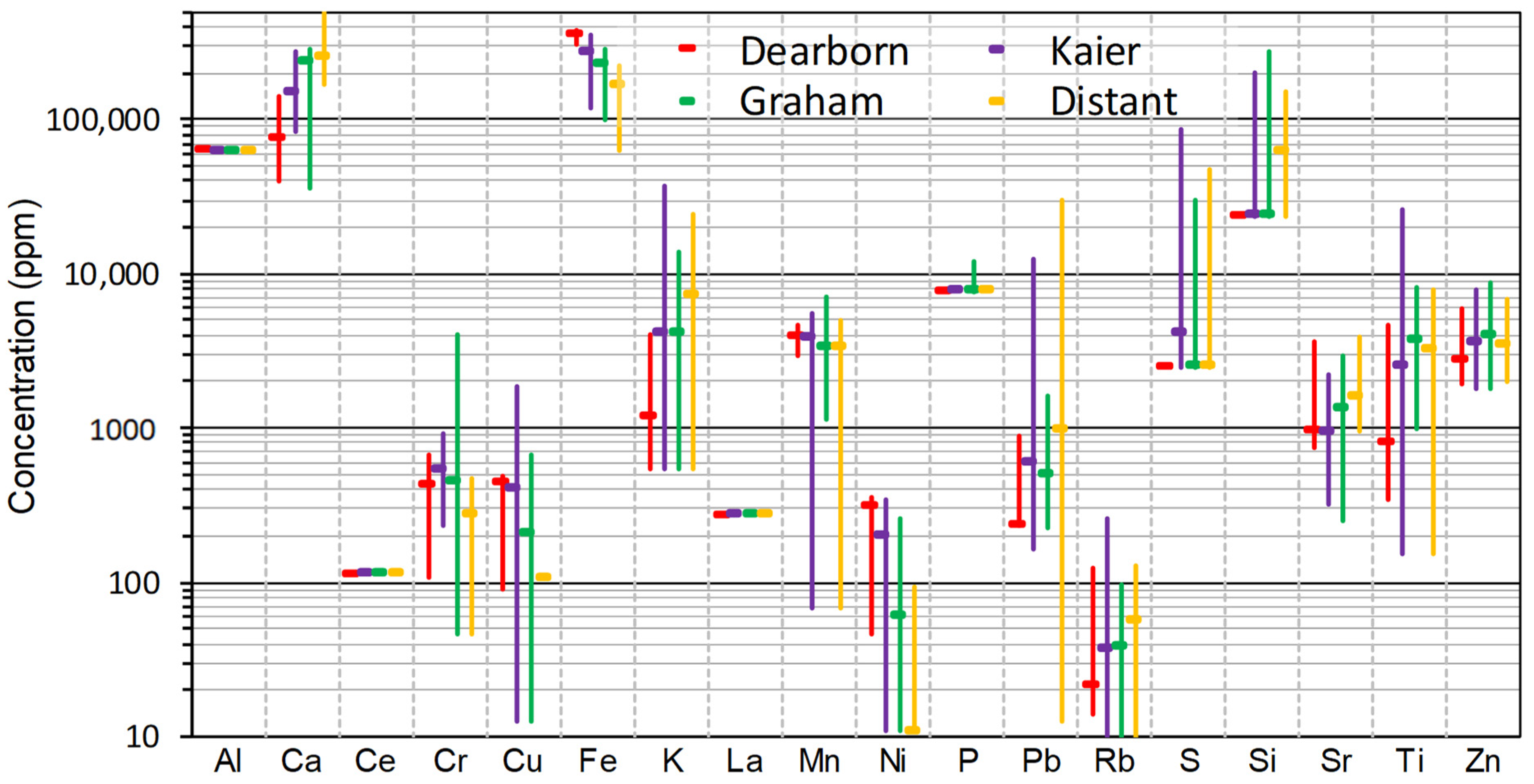
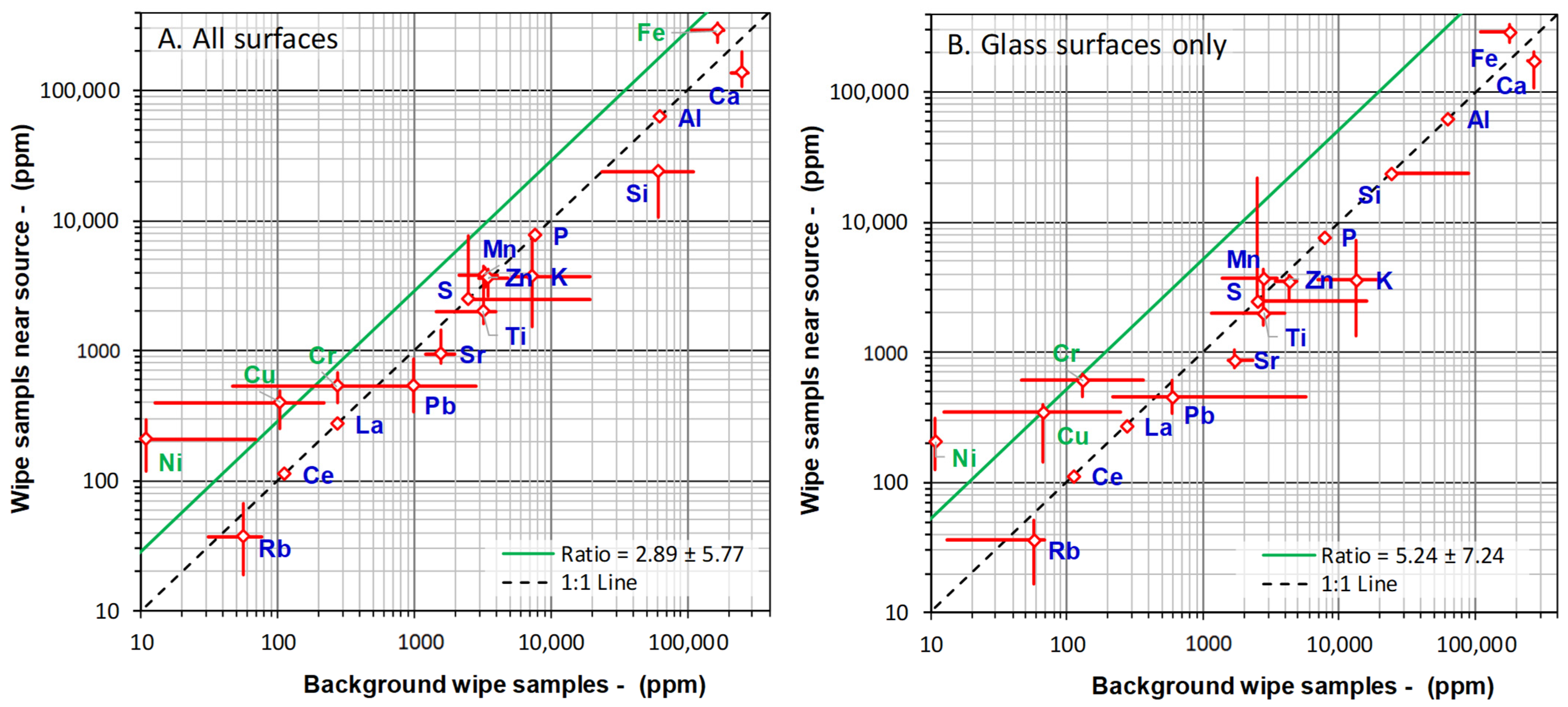

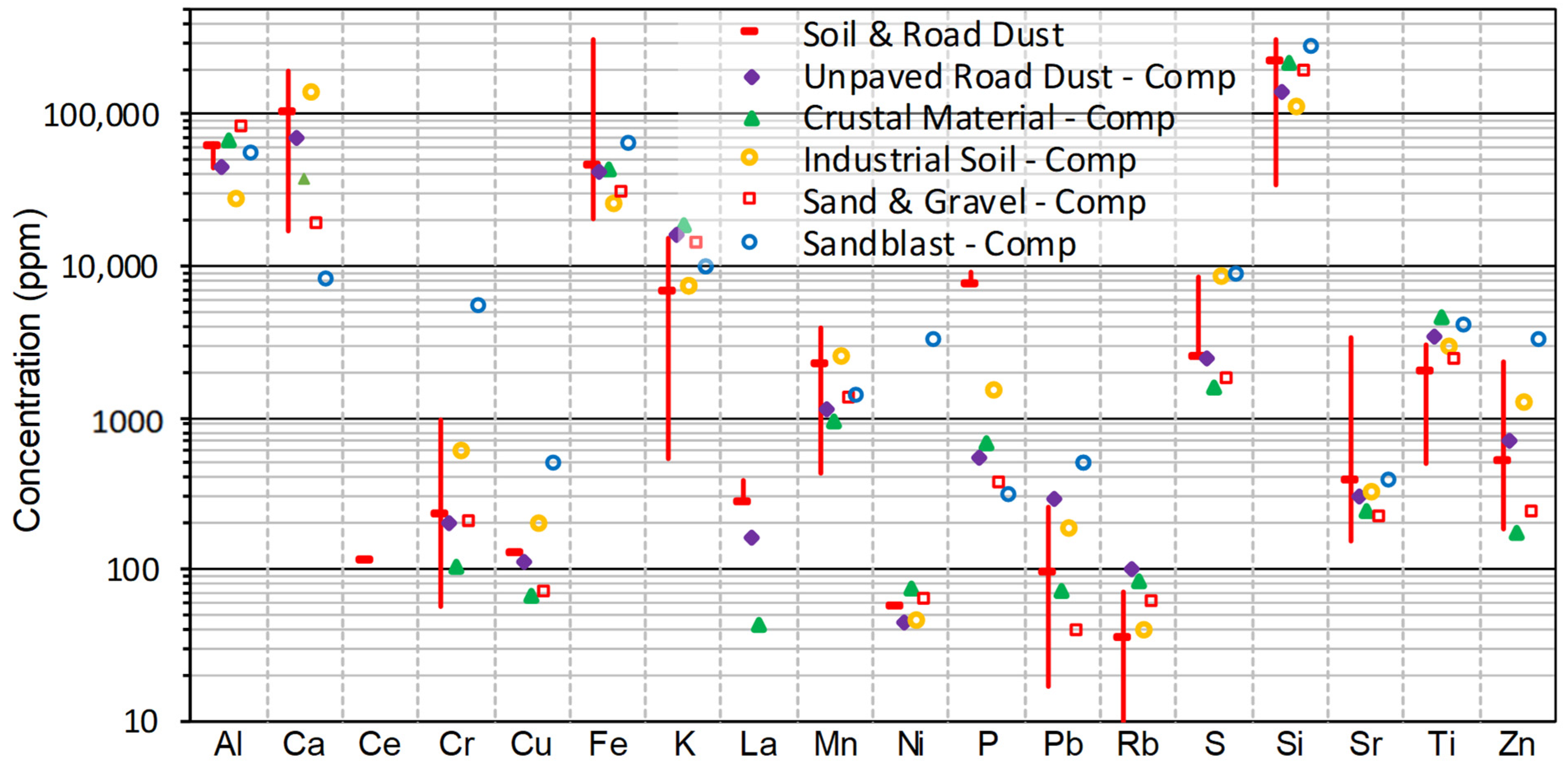

| Road Dust and Soil Samples | Wipe Samples | |||||||||
|---|---|---|---|---|---|---|---|---|---|---|
| Element | Street Dust Source Area | Street Dust Comparison | Soil | MDL | Dearborn | Kaier | Graham | Distant | MDL | |
| Al | 44,122 | 76,640 | 99,790 | 44,122 | 62,639 | 62,639 | 62,639 | 62,639 | 62,639 | |
| Ca | 111,631 | 88,165 | 44,714 | 1641 | 76,804 | 153,028 | 237,393 | 252,631 | 2330 | |
| Ce | 179 | 174 | 118 | 79 | 113 | 113 | 113 | 113 | 113 | |
| Cr | 718 | 171 | 131 | 33 | 475 | 583 | 497 | 320 | 46 | |
| Cu | 323 | 72 | 60 | 9 | 445 | 411 | 216 | 116 | 13 | |
| Fe | 224,374 | 29,940 | 29,043 | 492 | 355,447 | 272,095 | 231,080 | 166,882 | 698 | |
| K | 3865 | 12,121 | 12,961 | 380 | 1712 | 4681 | 4648 | 7786 | 539 | |
| La | 303 | 251 | 258 | 192 | 272 | 272 | 272 | 272 | 272 | |
| Mn | 3249 | 1620 | 631 | 49 | 3958 | 3855 | 3458 | 3369 | 69 | |
| Ni | 158 | 37 | 36 | 8 | 315 | 211 | 70 | 11 | 11 | |
| P | 5407 | 10,321 | 7247 | 5407 | 7676 | 7676 | 7676 | 7676 | 7676 | |
| Pb | 104 | 102 | 102 | 9 | 249 | 600 | 516 | 992 | 12 | |
| Rb | 16 | 49 | 58 | 2 | 24 | 40 | 41 | 59 | 3 | |
| S | 3747 | 5172 | 3015 | 1747 | 2480 | 6626 | 2480 | 2480 | 2480 | |
| Si | 122,379 | 282,903 | 300,909 | 16,721 | 23,739 | 23,739 | 23,739 | 85,043 | 23,739 | |
| Sr | 462 | 265 | 199 | 5 | 965 | 940 | 1339 | 1582 | 7 | |
| Ti | 1080 | 2468 | 2599 | 109 | 944 | 2679 | 3868 | 3369 | 154 | |
| Zn | 1079 | 380 | 275 | 15 | 2753 | 3639 | 3973 | 3506 | 21 | |
| N | 8 | 4 | 6 | - | 5 | 29 | 12 | 8 | - | |
| Detroit Road Dust/Sediment | Detroit Urban Soils | Michigan Natural Background | US EPA | |||||||||||||||||||||||
|---|---|---|---|---|---|---|---|---|---|---|---|---|---|---|---|---|---|---|---|---|---|---|---|---|---|---|
| Literature | This Study | Literature | This Study | Top Soil | Sand | Clay | Recommended | Screening Levels | ||||||||||||||||||
| Element | Howard et al., 2019 [21] | Denny et al., 2022 [12] | Street Dust-Source Area | Street Dust-Other | Howard et al., 2019 [21] | Murray et al., 2004 [22] | Denny et al., 2022 [12] | Soil | SE Michigan | Statewide | SE Michigan | Statewide | SE Michigan | Statewide | Default Background | Upper Range Background | Cancer | NonCancer | ||||||||
| Ag | - | 0.5 | - | - | - | 1.5 | 0.2 | - | <0.25 | <0.25 | <0.20 | <0.18 | <0.50 | <0.25 | 1.0 | 1.4 | - | 390 | ||||||||
| Al | - | - | 44,122 | 76,640 | - | - | - | 99,790 | 4554 | 2141 | 3024 | 2404 | 7445 | 7318 | 6900 | 16,014 | - | 77,000 | ||||||||
| As | 13 | 8 | - | - | 26 | 7 | 7 | - | 6 | 2 | 4 | 2 | 7 | 5 | 6 | 23 | 0.8 | 35 | ||||||||
| Ba | - | 343 | - | - | - | 122 | 381 | - | 40 | 24 | 28 | 13 | 64 | 48 | 75 | 172 | - | 15,000 | ||||||||
| Be | - | 0 | - | - | - | - | - | - | <0.20 | <0.30 | <0.20 | <0.20 | 0 | 0 | - | 1.0 | 1600 | 160 | ||||||||
| Cd | 9.2 | 1.1 | - | - | 3.4 | 3.7 | 0.7 | - | <2.0 | <2.0 | <0.24 | <0.20 | <1.1 | <0.66 | 1.2 | 2.0 | 2100 | 7 | ||||||||
| Co | - | - | - | - | - | - | - | - | <5.0 | <5.0 | 7 | 4 | 10 | 9 | 7 | 27 | 420 | 23 | ||||||||
| Cr | 136 | 207 | 718 | 171 | 212 | 58 | 99 | 131 | 13 | 6 | 4 | 3 | 17 | 14 | 18 | 56 | - | 0 | ||||||||
| Cu | - | 96 | 323 | 72 | - | 78 | 48 | 60 | 10 | 6 | 7 | 4 | 14 | 12 | 32 | 51 | - | 3100 | ||||||||
| Fe | - | - | 224,374 | 29,940 | - | - | - | 29,043 | 9476 | 4065 | 5863 | 4351 | 18,110 | 14,560 | 12,000 | 34,311 | - | 55,000 | ||||||||
| Hg | - | 0.1 | - | - | 0.4 | 0.2 | 0.1 | - | <0.10 | <0.10 | <0.05 | <0.05 | <0.06 | <0.06 | 0.1 | 0.5 | - | 11 | ||||||||
| Li | - | - | - | - | - | - | - | - | 4 | 2 | 4 | 3 | 19 | 16 | 10 | 38 | - | 160 | ||||||||
| Mg | - | - | - | - | - | - | - | - | 3184 | 2119 | 1411 | 1312 | 11,760 | 13,880 | - | 36,049 | - | - | ||||||||
| Mn | - | - | 3249 | 1620 | - | - | - | 631 | 524 | 137 | 89 | 81 | 321 | 290 | 440 | 1212 | - | 0 | ||||||||
| Mo | - | - | - | - | - | - | - | - | <5.0 | <5.0 | <1.0 | <1.0 | <2.5 | <2.2 | - | 5 | - | 390 | ||||||||
| Na | - | - | - | - | - | - | - | - | 125 | 101 | <88 | 51 | 114 | 178 | - | 519 | - | - | ||||||||
| Ni | 54 | 40 | 158 | 37 | 40 | 40 | 25 | 36 | 9 | 4 | 8 | 5 | 23 | 21 | 20 | 55 | 15,000 | 840 | ||||||||
| Pb | 171 | 137 | 104 | 102 | 256 | 135 | 105 | 102 | 12 | 9 | 6 | 3 | 9 | 8 | 21 | 39 | - | 400 | ||||||||
| Sb | - | - | - | - | - | - | - | - | - | - | <0.33 | <0.30 | <0.52 | <0.40 | - | 12 | - | 31 | ||||||||
| Se | - | 1.5 | - | - | - | 1.4 | 1.1 | - | <0.5 | <0.50 | <0.40 | <0.34 | <0.50 | <0.50 | 0.4 | 1.3 | - | 390 | ||||||||
| Sr | - | - | 462 | 265 | - | - | - | 199 | - | 106 | 28 | 12 | 102 | 100 | - | 150 | - | 47,000 | ||||||||
| Ti | - | - | 1080 | 2468 | - | - | - | 2599 | 95 | 127 | 150 | 117 | 100 | 120 | MNL | 208 | - | 47,000 | ||||||||
| Tl | - | - | - | - | - | - | - | - | <1.0 | <1.0 | <0.50 | <0.50 | <0.56 | <0.50 | - | 3 | - | 2 | ||||||||
| V | - | - | - | - | - | - | - | - | 21 | 15 | 10 | 8 | 23 | 21 | - | 60 | - | 390 | ||||||||
| Zn | - | 587 | 1079 | 380 | - | 236 | 206 | 275 | 40 | 21 | 24 | 12 | 44 | 34 | 47 | 118 | - | 23,000 | ||||||||
| Literature Profiles | |||||||||||||||||
|---|---|---|---|---|---|---|---|---|---|---|---|---|---|---|---|---|---|
| Detroit Profile | Type | Unpaved Road Dust | Industrial Soil | Sand & Gravel | Sandblast | Electric Arc Furnace | Auto Body Shredding | Fly Ash | Tire Dust | ||||||||
| Road dust—Source Area | Pearson | 0.43 | (0.11) | 0.66 | (0.01) | 0.54 | (0.04) | 0.50 | (0.06) | 0.34 | (0.21) | 0.19 | (0.49) | 0.14 | (0.63) | 0.47 | (0.08) |
| Spearman | 0.56 | (0.03) | 0.69 | (0.00) | 0.34 | (0.22) | 0.49 | (0.06) | 0.40 | (0.14) | 0.48 | (0.07) | 0.35 | (0.21) | 0.54 | (0.04) | |
| Road dust—Other Areas | Pearson | −0.02 | (0.93) | 0.20 | (0.48) | −0.20 | (0.47) | −0.17 | (0.55) | 0.02 | (0.95) | 0.14 | (0.63) | 0.17 | (0.54) | 0.08 | (0.79) |
| Spearman | 0.55 | (0.03) | 0.70 | (0.00) | 0.15 | (0.58) | −0.06 | (0.83) | 0.43 | (0.11) | 0.66 | (0.01) | 0.50 | (0.06) | 0.37 | (0.18) | |
| Background Soils | Pearson | 0.01 | (0.96) | 0.13 | (0.65) | −0.23 | (0.41) | −0.17 | (0.54) | 0.07 | (0.80) | 0.03 | (0.92) | 0.08 | (0.78) | 0.10 | (0.73) |
| Spearman | 0.36 | (0.18) | 0.33 | (0.23) | −0.01 | (0.97) | −0.16 | (0.57) | 0.33 | (0.22) | 0.34 | (0.21) | 0.31 | (0.26) | 0.20 | (0.47) | |
| Detroit Samples | Literature Profiles | |||||||||||
|---|---|---|---|---|---|---|---|---|---|---|---|---|
| Element | Road dust—Source Area | Road dust—Other Areas | Background Soils | Unpaved Road Dust | Industrial Soil | Sand & Gravel | Sandblast | Electric Arc Furnace | Auto Body Shredding | Fly Ash | Tire Dust | |
| Al | 0.2 | 0.7 | 1.0 | 0.7 | 0.4 | 1.2 | 0.8 | 0.2 | 0.1 | 0.8 | 0.0 | |
| Ca | 2.9 | 2.3 | 1.1 | 1.8 | 3.6 | 0.5 | 0.2 | 0.3 | 6.7 | 5.3 | 0.0 | |
| Cr | 6.6 | 1.3 | 1.0 | 1.9 | 5.7 | 1.9 | 52.4 | 4.0 | 6.1 | 3.4 | 0.3 | |
| Cu | 4.8 | 1.0 | 0.8 | 1.7 | 3.0 | 1.1 | 7.6 | 5.5 | 2.4 | 8.5 | 7.4 | |
| Fe | 5.1 | 0.7 | 0.7 | 0.9 | 0.6 | 0.7 | 1.4 | 0.5 | 4.7 | 1.1 | 0.1 | |
| K | 0.2 | 0.6 | 0.7 | 0.8 | 0.4 | 0.8 | 0.5 | 3.8 | 1.4 | 0.3 | 0.0 | |
| Mn | 3.4 | 1.6 | 0.6 | 1.2 | 2.6 | 1.4 | 1.5 | NA | 2.9 | 0.9 | 0.1 | |
| Ni | 2.0 | 0.4 | 0.4 | 0.6 | 0.6 | 0.8 | 42.7 | NA | 2.1 | 1.3 | 0.7 | |
| P | 2.4 | 9.5 | 5.1 | 0.8 | 2.2 | 0.5 | 0.5 | 1.8 | 3.3 | 3.6 | 1.8 | |
| Pb | 1.3 | 1.3 | 1.3 | 3.9 | 2.5 | 0.5 | 6.8 | 17.5 | 8.1 | 5.9 | 2.2 | |
| S | 1.5 | 2.4 | 1.1 | 1.6 | 5.2 | 1.1 | 5.5 | 8.2 | 17.1 | 14.8 | 6.5 | |
| Si | 0.5 | 1.2 | 1.3 | 0.7 | 0.5 | 0.9 | 1.3 | 0.2 | 0.1 | 0.3 | 0.0 | |
| Sr | 1.9 | 1.1 | 0.8 | 1.2 | 1.3 | 0.9 | 1.6 | NA | 4.7 | 3.7 | 0.3 | |
| Ti | 0.2 | 0.5 | 0.5 | 0.7 | 0.6 | 0.5 | 0.9 | 0.1 | 0.4 | 1.8 | 0.1 | |
| Zn | 6.0 | 2.1 | 1.5 | 4.1 | 7.1 | 1.3 | 18.4 | 26.6 | 5.2 | 4.0 | 30.1 | |
Disclaimer/Publisher’s Note: The statements, opinions and data contained in all publications are solely those of the individual author(s) and contributor(s) and not of MDPI and/or the editor(s). MDPI and/or the editor(s) disclaim responsibility for any injury to people or property resulting from any ideas, methods, instructions or products referred to in the content. |
© 2023 by the authors. Licensee MDPI, Basel, Switzerland. This article is an open access article distributed under the terms and conditions of the Creative Commons Attribution (CC BY) license (https://creativecommons.org/licenses/by/4.0/).
Share and Cite
Gearhart, J.; Sagovac, S.; Xia, T.; Islam, M.K.; Shim, A.; Seo, S.-H.; Sargent, M.C.; Sampson, N.R.; Napieralski, J.; Danielson, I.; et al. Fugitive Dust Associated with Scrap Metal Processing. Environments 2023, 10, 223. https://doi.org/10.3390/environments10120223
Gearhart J, Sagovac S, Xia T, Islam MK, Shim A, Seo S-H, Sargent MC, Sampson NR, Napieralski J, Danielson I, et al. Fugitive Dust Associated with Scrap Metal Processing. Environments. 2023; 10(12):223. https://doi.org/10.3390/environments10120223
Chicago/Turabian StyleGearhart, Jeff, Simone Sagovac, Tian Xia, Md Kamrul Islam, Albert Shim, Sung-Hee Seo, Melissa Cooper Sargent, Natalie R. Sampson, Jacob Napieralski, Ika Danielson, and et al. 2023. "Fugitive Dust Associated with Scrap Metal Processing" Environments 10, no. 12: 223. https://doi.org/10.3390/environments10120223
APA StyleGearhart, J., Sagovac, S., Xia, T., Islam, M. K., Shim, A., Seo, S.-H., Sargent, M. C., Sampson, N. R., Napieralski, J., Danielson, I., & Batterman, S. (2023). Fugitive Dust Associated with Scrap Metal Processing. Environments, 10(12), 223. https://doi.org/10.3390/environments10120223









